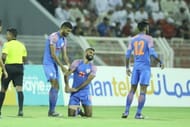India went down to their fourth straight competitive loss against Oman to stay win-less in Group E of the Second Round of the AFC 2022 FIFA World Cup qualifiers. Muhsen Al-Ghassani's 34th-minute goal condemned the Blue Tigers to their second loss of the campaign and put Igor Stimac's side mathematically out of contention for a spot in the third round of the qualifiers.
Stimac made three changes from the side that drew 1-1 against Afghanistan in Dushanbe with Nishu Kumar, Manvir Singh and Farukh Chaudhary replacing Pritam Kotal, Sahal Abdul Samad and Mandar Rao Dessai.
From the first minute, Oman were comfortable in possession and even missed an early penalty. But Mushen Al-Ghassani made amends for his gaffe from the spot with a neat finish, although there were suggestions that he was offside before receiving the pass from Mohsin Al-Khaldi.
We take a look at three reasons why India lost the game.
#3 Where was the offensive plan?

Throughout his tenure as India manager, Stephen Constantine was ridiculed for the way his side resorted to route-one football at the first attempt, without even making an attempt to play through midfield.
Eleven games into his tenure and a lot of tall talk later, there isn't seemingly much that Stimac has changed. Yes, India keep more possession. But all the possession is between the centre-backs and the central midfielders, who keep the ball for a spell and then decide to hoof it long.
Manvir had a torrid night, with nothing sticking. Farukh worked hard, but his quality deserted him in the face of some robust Omani defending. Udanta Singh seemed to be the outlet for India but even he was isolated on the right wing and, despite a few decent runs, he could not provide an end-product.
Now, a lot has been said about Sunil Chhetri and his inability to finish off chances recently, but what is beyond question is that he's still India's best creative force and the best goalscorer.
So, why then does a manager's gameplan seemingly revolve around entirely bypassing his strengths?
Despite the passing talent of Brandon Fernandes and Vinit Rai, there was not one pass played through the lines into the spaces that Chhetri loves, in between the midfield and the defence. The result was that the skipper had to come too deep to pick up possession and that resulted in there being no one in the final third to make the killer pass or take a snapshot at goal.
India ended the game with no shots. Yes, let that sink in. One isn't talking shots on target. India did not have a single shot. The only two times Ali Al-Habsi was troubled in the Oman goal was when Chhetri cut back from a Brandon free-kick and from a deflected Ashique Kuruniyan cross, both of which he dealt with comfortably.
That means that in ten games now, under Stimac, India have scored only four goals from open play, with six coming directly off set-pieces. Off the four scored in open play, too, Anirudh Thapa's goal against Thailand in the King's Cup was in the second phase of play after a set-piece.
It's all well and good to have a prowess in scoring from set-pieces, but India seem bereft of ideas from open play. And, that is sure to cause more than a furrowed brow or two.
#2 Injury gambles backfire with no room for attacking substitutions

Both Adil Khan and Pronay Halder came into the game with niggles that they had picked up in Dushanbe. Hence, it was a gamble from Stimac to put both of them in the starting lineup.
Sure enough, 35 minutes into the game, India were forced to make two substitutions, with both Halder and Adil forced off, being replaced by Vinit Rai and Anas Edathodika.
It's clear why Stimac wanted Adil to start the game. Anas had just joined the camp in Muscat after a family emergency had forced him out of the game in Dushanbe. Rahul Bheke has been tentative in his initial days in an India shirt and Sarthak Golui hasn't played competitive international football for quite some time.
That meant that Stimac possibly felt he had to take the risk of starting Adil and from the first minute, he didn't look quite right, being very reluctant to engage in duels or a foot-race with Al-Ghassani.
It was the same with Halder, who also picked up an early shoulder injury in a duel with Al-Mandhar Al-Alawi, which restricted his mobility even further. He would go on to pick up a yellow card for cynically stopping an Omani counter-attack, before being replaced.
These two early jolts, coupled with Rahul Bheke's injury in the second half, meant that Stimac couldn't make the changes he would have wanted to make to alter the scoreline and chase the game.
The likes of Seiminlen Doungel, who scored the equaliser against Afghanistan, Sahal Abdul Samad and Anirudh Thapa were left warming the bench till the end.
It was a very avoidable situation for Stimac, given that the likes of Raynier Fernandes and Vinit were available to start in midfield, alongwith Anas and Golui who eventually came on.
#3 Square Pegs in Round Holes

India started the game with six Bengaluru FC players. Bengaluru play a passing style of football that revolves around the likes of Dimas Delgado in midfield, which ultimately brings the best out of the likes of Chhetri and Udanta.
India don't have the luxury of a controller of the quality of Dimas. So, Stimac has decided to drop Brandon Fernandes into a deeper role to control possession and the tempo of play.
But Brandon, for all his precocious talent, is just not that kind of player. He's more in the Chhetri mould, a player who loves drifting into spaces in midfield, and playing through balls and taking shots from there.
In this role, Brandon is only recycling possession off centre-backs, and then hitting long and hoping it sticks. Using him this way is such a disservice to the talent he possesses. And, it beggars belief that Stimac has found Brandon for this role, where there's a more natural fit for that role in Anirudh Thapa.
It's a stark reminder of the way in which Constantine used Eugeneson Lyngdoh in a much deeper role for the national team, curbing a lot of the positive qualities that Lyngdoh had, which meant the man from Meghalaya never really shone bright on the international stage, at least never at the levels he managed for Bengaluru FC.
Similarly, the left-back conundrum India have gotten into, is also leading to a lot of confusion. Sergio Lobera successfully transformed a flying winger in Mandar into a left-back, but that doesn't mean every winger can be as effective.
Ashique Kuruniyan fought gamely, defended his one-on-ones really well, went forward when he could, but were India using his talent the best they could? Now, there's a natural left-back in the squad, too, in Subhasish Bose. So, what is the point of these experiments in tough competitive games?
Stimac is faced with plenty of questions. But, the conundrum he faces is that in trying to answer some of them, he has only created more questions.
With a game against Afghanistan at home and another away to Bangladesh coming up later in the campaign, Stimac knows that he needs to show some results to back up the process that he's trying to build.
